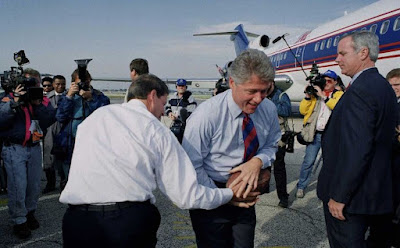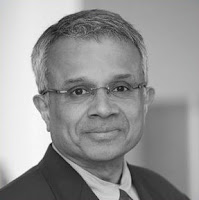Rajan Menon on America’s “strategic blunder” of the 1990s
that set the stage for today's Ukrainian crisis.
Rajan Menon (left) is a Professor of International Relations emeritus at the Powell School, City College of New York and director of the Grand Strategy Program at Defense Priorities, and Senior Research Scholar at the Saltzman Institute of War and Peace at Columbia University. He is also a regular contributer to TomDispatch.com, which bills itself as “a regular antidote to the mainstream media.” In his latest piece (one that’s also published over at The Nation), Menon observes that we’re acting as if the Ukraine situation came out of nowhere thanks to the actions of Russian president Vladimir Putin, when it’s actually a “post-Cold War train wreck long in the making.” Following is an excerpt.
Understandably enough, commentaries on the crisis between Russia and the West tend to dwell on Ukraine. After all, more than 100,000 Russian soldiers and a fearsome array of weaponry have now been emplaced around the Ukrainian border. Still, such a narrow perspective deflects attention from an American strategic blunder that dates to the 1990s and is still reverberating.
During that decade, Russia was on its knees. Its economy had shrunk by nearly 40%, while unemployment was surging and inflation skyrocketing. (It reached a monumental 86% in 1999.) The Russian military was a mess. Instead of seizing the opportunity to create a new European order that included Russia, President Bill Clinton and his foreign-policy team squandered it by deciding to expand NATO threateningly toward that country’s borders. Such a misbegotten policy guaranteed that Europe would once again be divided, even as Washington created a new order that excluded and progressively alienated post-Soviet Russia.
The Russians were perplexed – as well they should have been.
At the time, Clinton and company were hailing Russian President Boris Yeltsin as a democrat. (Never mind that he had lobbed tank shells at his own recalcitrant parliament in 1993 and, in 1996, prevailed in a crooked election, abetted weirdly enough by Washington.) They praised him for launching a “transition” to a market economy, which, as Nobel Laureate Svetlana Alexievich so poignantly laid out in her book Second Hand Time, would plunge millions of Russians into penury by “decontrolling” prices and slashing state-provided social services.
Why, Russians wondered, would Washington obsessively push a Cold War NATO alliance ever closer to their borders, knowing that a reeling Russia was in no position to endanger any European country?
An Alliance Saved from Oblivion
Unfortunately, those who ran or influenced American foreign policy found no time to ponder such an obvious question. After all, there was a world out there for the planet’s sole superpower to lead and, if the U.S. wasted time on introspection, “the jungle,” as the influential neoconservative thinker Robert Kagan put it, would grow back and the world would be “imperiled.” So, the Clintonites and their successors in the White House found new causes to promote using American power, a fixation that would lead to serial campaigns of intervention and social engineering.
The expansion of NATO was an early manifestation of this millenarian mindset. . . . [W]hy use that opportunity to expand NATO, which had been created in 1949 to deter the Soviet-led Warsaw Pact from rolling into Western Europe, given that both the Soviet Union and its alliance were now gone? Wasn’t it akin to breathing life into a mummy?
To that question, the architects of NATO expansion had stock answers, which their latter-day disciples still recite. The newly born post-Soviet democracies of Eastern and Central Europe, as well as other parts of the continent, could be “consolidated” by the stability that only NATO would provide once it inducted them into its ranks. Precisely how a military alliance was supposed to promote democracy was, of course, never explained, especially given a record of American global alliances that had included the likes of Philippine strongman Ferdinand Marcos, Greece under the colonels, and military-ruled Turkey.
And, of course, if the denizens of the former Soviet Union now wanted to join the club, how could they rightly be denied? It hardly mattered that Clinton and his foreign policy team hadn’t devised the idea in response to a raging demand for it in that part of the world. Quite the opposite, consider it the strategic analog to Say’s Law in economics: they designed a product and the demand followed.
Domestic politics also influenced the decision to push NATO eastward. President Clinton had a chip on his shoulder about his lack of combat credentials. Like many American presidents (31 to be precise), he hadn’t served in the military, while his opponent in the 1996 elections, Senator Bob Dole, had been badly injured fighting in World War II. Worse yet, his evasion of the Vietnam-era draft had been seized upon by his critics, so he felt compelled to show Washington’s power brokers that he had the stomach and temperament to safeguard American global leadership and military preponderance.
To read Rajan Menon’s article “How Did We Get Here?” in its entirety, click here.
Quote of the Day – February 24, 2022
Related Off-site Links:
US-NATO Militarism Is the Cause, Not the Solution – Khury Petersen-Smith (In These Times via Common Dreams, February 9, 2022).
Is a Peaceful Resolution Still Possible? Masha Gessen and Anatol Lieven on Ukraine, Putin and NATO – Democracy Now! (February 7, 2022).
What the Cuban Missile Crisis Can Teach Us About Ending Hostility in Ukraine – Lawrence Wittner (Common Dreams, February 7, 2022).
Russian Historian: We Need Both the U.S. and Russia to Deescalate Crisis over Ukraine – Democracy Now! (February 3, 2022).
See also the previous Wild Reed post:
• In Search of a “Global Ethic”
Image: Bill Clinton and Al Gore in 1992. (Photo: Stephan Savoia / AP)























No comments:
Post a Comment